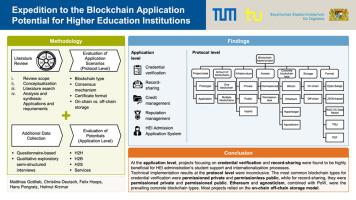Revealing Success: Case Studies of blockchain in Higher Education
Blockchain technology is much more than just the backbone of cryptocurrencies. In recent years, it has begun to transform higher education, offering unparalleled clarity, data security, and efficiency. From certifying credentials to securing academic records, blockchain in higher education is redefining what’s possible in the digital age.
The Rise of Blockchain in Higher Education
Higher education institutions around the globe are challenged to offer trustworthy certification, streamline administrative processes, and foster trust among international stakeholders. Blockchain, best known for its tamper-resistant and decentralized ledger, presents several innovative solutions to these hurdles.
- Secure digital diplomas and transcripts
- Verification of credentials across borders
- Efficient transfer of credits between institutions
- Improved record-keeping and fraud prevention
- Smart contracts for streamlined administration
Key Benefits of Blockchain in Higher Education
Understanding the benefits of blockchain technology in higher education is basic for institutions considering its adoption. Here are some significant advantages:
- Transparency: Blockchain’s distributed ledger provides a transparent, tamper-proof record of all academic achievements and changes.
- Data Security: Sensitive student data is encrypted and securely stored, mitigating risks of data breaches.
- Cost Efficiency: Automation via smart contracts can drastically reduce administrative costs and errors.
- Global Compatibility: Blockchain enables seamless cross-border recognition of degrees and certifications.
Case Studies: Blockchain Empowering Higher Education
To reveal the true impact of blockchain, let’s dive into several blockchain case studies in higher education from globally recognized institutions.
1. Massachusetts Institute of Technology (MIT): Secure Digital Diplomas
MIT blazed a trail by issuing blockchain-based digital diplomas to its graduates via the Blockcerts platform.These tamper-resistant credentials not only enable graduates to instantly share verified records with employers but also eradicate the risk of forged diplomas.
- Students control and share their digital certificates safely.
- Employers and other universities can verify qualifications instantly without contacting MIT.
Key takeaway: Blockchain enhances the value and trustworthiness of academic records.
2. University of Nicosia: Blockchain for Academic credentials
The University of Nicosia in Cyprus, a pioneer in blockchain education, now issues blockchain-based academic certificates and transcripts. Their solution has also enabled the university to offer the world’s first Master’s degree in Digital Currency.
- Real-time verification reduces processing time for credential checks.
- Streamlined admissions and job application processes.
key takeaway: Adoption of blockchain can enhance an institution’s reputation and attract a new wave of students who value transparency and innovation.
3. University of Melbourne: Verifiable Digital Credentials
In Australia, the University of Melbourne implemented a blockchain strategy to provide digital versions of academic credentials. Through the Learning Machine platform, students can now access authenticated documentation securely from anywhere in the world.
- Students benefit from instant,borderless access to verifiable transcripts.
- Employers save time and resources in candidate verification.
Key takeaway: Blockchain eliminates borders in academic verification, making credentials universally accessible.
4. Sony Global Education and IBM: Blockchain for Data Exchange
Sony Global education, in partnership with IBM, piloted a blockchain system to manage student data and achievement records among Japanese educational institutions.
- Unifies data from multiple sources on a single, trusted platform.
- Enables educational mobility by ensuring the validity of credit transfers.
Key takeaway: Cross-institutional cooperation enabled by blockchain smooths student mobility and lifelong learning.
5. Central New Mexico Community College: Digital Diplomas at Scale
Central New mexico Community College (CNM) became the first community college in the United states to offer blockchain-based digital diplomas, providing graduates instant access to their credentials. This shift drastically reduced transcript request times and administrative overhead.
- Immediate and secure access to credentials for all graduates.
- Lower risk of lost or delayed diplomas, benefiting both students and employers.
Key takeaway: Blockchain can offer cost-effective solutions for a broad range of institutions,from elite universities to community colleges.
firsthand Experience: What Educators and graduates Say
“As receiving my digital diploma from MIT, I’ve been able to apply to jobs around the globe. Verification is instant and trustworthy, giving me confidence in my academic record.”
— julia, MIT Graduate
“Blockchain technology has reduced our administrative workload significantly, freeing our staff to focus more on students and less on paperwork.”
— Mark, Higher Education Registrar
Implementation Tips for Institutions
Ready to explore blockchain solutions for higher education? Consider the following practical tips to ensure a smooth transition:
- Pilot with a single Use Case: Start with digital diplomas or transcript verification to evaluate effectiveness before expanding.
- Partner with Tech Leaders: Collaborate with established blockchain service providers such as IBM Blockchain or educational platforms like Blockcerts.
- Invest in Training: Educate staff and faculty about blockchain benefits and proper usage.
- Ensure Regulatory Compliance: Stay up-to-date with local and international data privacy regulations (e.g., GDPR, FERPA).
- Communicate Benefits to Stakeholders: Share the impact of blockchain adoption with students, employers, and accreditation bodies.
Potential Challenges to Consider
While blockchain promises significant upside, institutions should be aware of the following obstacles:
- Integration Complexity: Incorporating blockchain with existing legacy systems can be challenging.
- Change management: Faculty and administration may require time to adapt to new processes.
- Scalability: Some blockchain solutions may need upgrades to handle large volumes of records efficiently.
- Regulatory Ambiguity: A rapidly evolving legal landscape around data security and blockchain usage.
Conclusion: the Future of Blockchain in Higher education
The prosperous adoption of blockchain in higher education is already a reality—as proven by leading universities and colleges around the world. As more institutions seek to enhance trust, reduce fraud, and deliver seamless services to students, blockchain stands out as a critical enabler. From issuing digital diplomas and keeping secure academic records to simplifying global credential verification,blockchain is driving a new era of transparency and efficiency in academia.
By learning from these pioneering case studies, educational leaders can chart a path toward innovation and build systems that not only meet today’s demands but also anticipate tomorrow’s challenges. Investing in blockchain technology is more than an upgrade—it’s a commitment to building a future-ready institution.

